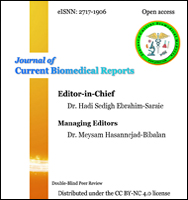Machine learning, infection, microbial toxins profile and health monitoring pre/post general surgeries during COVID-19 pandemic
Abstract
Although almost 2 years have passed since the beginning of the coronavirus disease 2019 (COVID-19) pandemic in the world, there is still a threat to the health of people at risk and patients. Specialists in various sciences conduct various research in order to eliminate or reduce the problems caused by this disease. Surgery is one of the sciences that plays a critical role in this regard. Both physicians and patients should pay attention to the potent steps of different infections’ key-points during pre/post-general surgeries in the case of preventing or accelerating the healing process of nosocomial acquired COVID-19. The relationship between COVID-19 and general surgical events is one of the factors that could directly or indirectly play a key role in the body's resilience to COVID-19. In this article, we introduce a link between pre/post-general surgery steps, human microbial toxin profiles, and the incidence of acquired COVID-19 in patients. In linking the components of this network, artificial intelligence (AI), machine learning (ML) and data mining (DM) can be important strategies to assist health providers in choosing the best decision based on a patient’s history.
Keywords
Full Text:
Full-text PDFReferences
Liu Z, Zhang Y, Wang X, Zhang D, Diao D, Chandramohan K, et al. Recommendations for surgery during the novel coronavirus (COVID-19) epidemic. Indian J Surg. 2020;82(2):124–8.
Cooper RA. Surgical site infections: epidemiology and microbiological aspects in trauma and orthopaedic surgery. Int Wound J. 2013;10(s1):3–8.
Thompson RL, Cabezudo I, Wenzel RP. Epidemiology of nosocomial infections caused by methicillin-resistant Staphylococcus aureus. Ann Intern Med. 1982;97(3):309–17.
Nagachinta T, Stephens M, Reitz B, Polk BF. Risk factors for surgical-wound infection following cardiac surgery. J Infect Dis. 1987;156(6):967–73.
Ambrose NP. Use of pre-operative Procalcitonin and C-reactive Protein measurements as biomarker of post-operative infective complications of Pancreaticoduodenectomy. Christian Medical College, Vellore; 2020.
Zhu Y, Simon GJ, Wick EC, Abe-Jones Y, Najafi N, Sheka A, et al. Applying machine learning across sites: external validation of a surgical site infection detection algorithm. J Am Coll Surg. 2021;232(6):963–71.
Haridas M, Malangoni MA. Predictive factors for surgical site infection in general surgery. Surgery. 2008;144(4):496–503.
Lee HG, Jang J, Choi JE, Chung DC, Han JW, Woo H, et al. Blood stream infections in patients in the burn intensive care unit. Infect Chemother. 2013;45(2):194–201.
Estahbanati HK, Kashani PP, Ghanaatpisheh F. Frequency of Pseudomonas aeruginosa serotypes in burn wound infections and their resistance to antibiotics. Burns. 2002;28(4):340–8.
Hedayati Ch M, Abedinzade M, Khanaki K, Khakpour Tleghani B, Golshekan M, Mohammadi E. Comparative Protective Effects of Viola Spathulata, Urtica Dioica, and Lamium Album on Endoplasmic Reticulum (ER) Stress in Rat Stroke Model. Casp J Neurol Sci. 2021;7(3):172–9.
Panayidou S, Ioannidou E, Apidianakis Y. Human pathogenic bacteria, fungi, and viruses in Drosophila: disease modeling, lessons, and shortcomings. Virulence. 2014;5(2):253–69.
Bone RC. Gram-negative sepsis: a dilemma of modern medicine. Clin Microbiol Rev. 1993;6(1):57–68.
Elek SD, Conen PE. The virulence of Staphylococcus pyogenes for man. A study of the problems of wound infection. Br J Exp Pathol. 1957;38(6):573.
Setlow P. Spore resistance properties. Microbiol Spectr. 2014;2(5):2–5.
Arciola CR, Campoccia D, Montanaro L. Implant infections: adhesion, biofilm formation and immune evasion. Nat Rev Microbiol. 2018;16(7):397–409.
Atiyeh BS, Costagliola M, Hayek SN, Dibo SA. Effect of silver on burn wound infection control and healing: review of the literature. burns. 2007;33(2):139–48.
Owens CD, Stoessel K. Surgical site infections: epidemiology, microbiology and prevention. J Hosp Infect. 2008;70:3–10.
Fletcher RR, Olubeko O, Sonthalia H, Kateera F, Nkurunziza T, Ashby JL, et al. Application of machine learning to prediction of surgical site infection. Annu Int Conf IEEE Eng Med Biol Soc. 2019 Jul;2019:2234-2237.
Stevens DL, Bisno AL, Chambers HF, Everett ED, Dellinger P, Goldstein EJC, et al. Practice guidelines for the diagnosis and management of skin and soft-tissue infections. Clin Infect Dis. 2005;41(10):1373–406.
Gingold MJ, Bystrzycki AB, Cicuttini FM. Textbook of Adult Emergency Medicine.
Mahdavi M, Choubdar H, Zabeh E, Rieder M, Safavi-Naeini S, Jobbagy Z, et al. A machine learning based exploration of COVID-19 mortality risk. PLoS One. 2021;16(7):e0252384.
Maglogiannis I, Kontogianni G, Papadodima O, Karanikas H, Billiris A, Chatziioannou A. An integrated platform for skin cancer heterogenous and multilayered data management. J Med Syst. 2021;45(1):1–13.
da Silva DA, Ten Caten CS, Dos Santos RP, Fogliatto FS, Hsuan J. Predicting the occurrence of surgical site infections using text mining and machine learning. PLoS One. 2019;14(12):e0226272.
Lavrač N. Selected techniques for data mining in medicine. Artif Intell Med. 1999;16(1):3–23.
Patel L, Shukla T, Huang X, Ussery DW, Wang S. Machine learning methods in drug discovery. Molecules. 2020;25(22):5277.
Moses JC, Adibi S, Shariful Islam SM, Wickramasinghe N, Nguyen L. Application of Smartphone Technologies in Disease Monitoring: A Systematic Review. Healthcare (Basel). 2021 Jul 14;9(7):889.
Platt MJ, Cans C, Johnson A, Surman G, Topp M, Torrioli MG, et al. Trends in cerebral palsy among infants of very low birthweight (< 1500 g) or born prematurely (< 32 weeks) in 16 European centres: a database study. Lancet. 2007;369(9555):43–50.
Refbacks
- There are currently no refbacks.
Copyright (c) 2022 © The Author(s)

This work is licensed under a Creative Commons Attribution-NonCommercial 4.0 International License.













